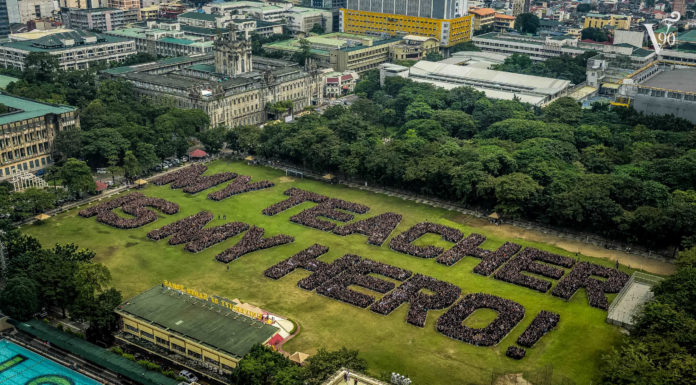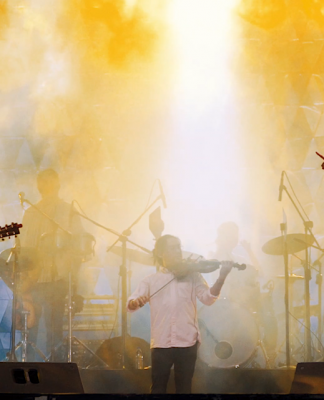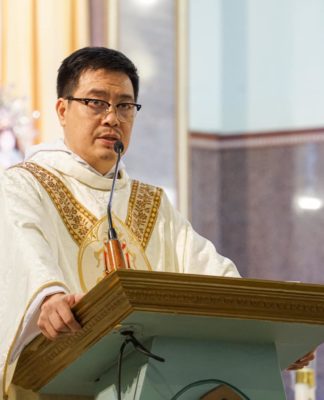MORE THAN nine million people clad in maroon and yellow filled the streets surrounding Quiapo last Jan. 9, clutching their white towels and handkerchiefs and throwing these to the marshalls to wipe the miraculous image of Jesus, the Black Nazarene.
Since 1963, Renato Roquiño has been struggling among the mass of devotees who believe in the image’s power to change lives. The 64-year-old manghihilot or taga-tawas travelled from Bulacan to be a part of this year’s procession. “Manalangin lang kayo. Hindi kayo pababayaan noon,” he said.
Roquiño claimed the Black Nazarene has granted him many blessings. But the “biggest miracle” was when he was spared from a heavy storm that hit his province. He remembered praying to the Black Nazarene, pleading for his life.
“Marami kami ‘nun, sa Leyte, nagdagat kami, at inabutan ng malakas na bagyo. Siyam na basneg (nets) ang nabagyo, lahat nadurog. ‘Yung sa amin lang ang natira,” he added.
Despite the unbearable heat, fatigue and great discomfort from blisters, young and old Catholics never wavered in their faith and struggled to wipe their towels on the image of the Black Nazarene, or at least touch the rope connected to the carroza of the centuries-old image.
Alejandro Cabigting, 74, was one of the barefoot believers who walk toward Quirino Grandstand from Quiapo Church every year to join the annual procession.
“[Ang paglakad ng nakapaa ay] tanda ng panata at pag-alay [para sa poong Nazareno]. Ito ay parang pagpapakita ng paggalang, parang kapag papasok ka ng bahay,” Cabigting said.
Joavy Llanto, eight months pregnant and a member of Soldiers of Christ, admitted that she experienced difficulty in joining the procession this year, her first time. “Nahirapan ako lumabas, ‘yung tiyan ko naipit,” she said.
Llanto, accompanied by her husband, travelled from Quezon City to Quiapo at around 4 a.m., undaunted by the crowd size or any untoward incident that could happen to her. She prayed for the safe delivery of her child and for the well being of their family.
According to media reports, more than 1,400 devotees were treated for wounds, exhaustion, dehydration, chest pains, and even seizures. This year’s procession lasted for 19 hours.
Dr. Fernando Nakpil Zialcita of Ateneo de Manila University’s Department of Sociology and Antropology said Filipinos are able to identify with the image of the Black Nazarene. This is why it is able to draw large crowds.
Most of the devotees are from the low economic classes, asking for special graces from the Black Nazarene. Unlike educated Catholics, who tend to be less physical, Nazarene devotees are not exposed to theology and philosophy, according to Zialcita.
“When you are exposed to theology and philosophy, mas inward ang pananampalataya,” he said.
Nazareno throughout the ages
The life-sized, dark-colored, wooden sculpture of Jesus Christ known as the Black Nazarene was carved by a Mexican-Indian artist and came from Acapulco, Mexico on board a galleon.
No existing records tell when exactly the image of the Black Nazarene arrived in the country. Zialcita said he had searched archives and historical documents but came up with no answer.
Speculations abound on its color. It was said that when missionaries brought the icon to Manila, fire broke out on the vessel. The icon of the Black Nazarene caught fire, causing its dark color. Despite its condition, the Nazarene was kept safe and honored from then on.
Zialcita refuted this, saying the image has been black ever since. “So many images in Catholic [and] Christianity are black. In Europe, the virgins were black, [like the] patroness of Poland, (the Black Madonna of Cz?stochowa),” he said.
Other black images include Sto. Niño in Tanggapan and Santo Cristo de Longos in Tondo.
The anthropologist suggested that the black shade was common among images in an agrarian society, where the color of the saints was often associated with the fertility of the soil.
“Catholicism developed in agrarian society. The farmers in the society have identified with figures that are black kasi ganun talaga ang matabang lupa,” Zialcita said.
The Black Nazarene made a lot of miraculous deeds. The image survived the great fires that destroyed Quiapo Church in 1791 and 1929, the great earthquakes of 1645 and 1863, and the bombing of Manila in 1945 during World War II.
Today, the head and the cross of the original image are housed in the Altar Mayor of the Quiapo Church, while the original body of the Black Nazarene is used during processions.
Devotion to Nazareno
In his homily at Saint John the Baptist Church or Quiapo Church on Jan. 9, Bishop Broderick Pabillo noted that the devotees were never forced in professing their strong devotion to the Black Nazarene.
“Nakikita ko ‘yung tuwa at kapayapaan sa loob nila,” Pabillo said, referring to the people he interviewed before the Mass. “Tayong mga deboto, hindi tayo natatakot sa kahirapan at sakripisyo. Sa pamamagitan nito, tayo ay magtatagumpay.”
Pabillo said the Holy Cross, a symbol of punishment for sinners back then, became the instrument of salvation as Jesus Christ carried it without anger or resentment. Thus, the cross can also become a symbol of success if Christians learn to bear it with love.
Msgr. Jose Clemente Ignacio, parish priest of Quiapo Church, said in his article titled “Devotion to the Black Nazarene: Pastoral Understanding” published for the celebration of the feast, that the tradition liberates the heart of the devotees.
He added that the secret force of the pilgrimage is the movement it brings to the heart and the intensified excitement of one’s faith and religion.
“It is here where they receive a [kind of] ‘liberation,’ undergoing a direct experience of the sacred, either in the material aspect of miraculous healing or in the immaterial aspect of inward transformation of spirit and personality,” Ignacio said.
Touching or kissing Catholic images does not mean idolatry. It is a symbol of “concreteness,” which is one of the traits of religious Filipinos. “Filipinos are a people of ‘the concrete.’ Our expressions are expressed in the concrete. It is a Filipino trait to wipe, touch, kiss, or embrace sacred objects. We Filipinos believe in the presence of the Divine in sacred objects and places. This is a way of expressing one’s faith. It is an expression of their devotion,” he said.
Pabillo reminded the devotees that as they pray for their personal intentions and wipe their towels on the image, they should also ask for God’s will.
“Hindi lang po sa pisikal na paghahawak [ang pagiging malapit sa Diyos],” he noted. “Tayo ay maging malapit sa Kaniyang kalooban. Para maging isa sa kaniya, hanapin natin ang kaniyang kagustuhan.”
Ignacio said that if one looks at the image carefully, it could be interpreted as Christ standing up after the fall.
















